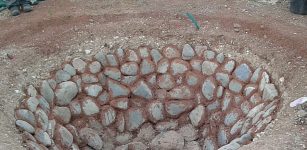Yew: Mysterious Ominous And Sacred Tree Revered By Our Ancestors Since The Dawn Of Civilization
Angela Sutherland - AncientPages.com - There is a mysterious, ominous, and sacred tree of yew among many trees revered by ancient cultures since the dawn of human civilization.
The trunk of the Ankerwyke Yew. Image credit: Imran - CC BY 3.0 CC
Like other sacred trees on our planet, also the yew is surrounded by fabulous stories that go long back in time. Ancient people regarded the yew tree as a portal leading to an unknown world.
In one Irish tale, a tragic heroine, Deirdre, threw herself from the chariot, dashing her head to pieces against a rock.
And ‘when they buried her, it is said there grew from her grave and from Naisi’s two yew-trees, whose tops, when they were full-grown, met each other over the roof of the great church of Armagh, and intertwined together, and none could part them.’ 1
The yew is native to western, central, and southern Europe (including Britain, Ireland, and Gaul), northwest Africa, northern Iran, and southwest Asia. In Britain, sacred trees, including yew trees, can be found in or near many traditional Druid ceremonial sites scattered across the country’s landscape. The Druids and others regarded the yew as the symbol of both transformation and eternity used yew sticks for prophecy and witchcraft.
Yew trees grow very slowly and give birth to red berries, medicine, and poison. Long believed to be a traditional symbol of immortality, they represented something exceptional in old beliefs.
Evergreen plants can live for as long as 2,000 years or even longer. They are called “trees of longevity” and maintain their beautiful dark green color practically throughout the year, even in winter. They are among some of the longest-living trees on our planet.
From time immemorial, it has been planted at the burial ground, along with other evergreens and long-lived trees and shrubs, most likely to express human beings’ hope for a continued life that can extend beyond the death of the body, beyond the physical world.
Like other sacred trees, the yew tree also functioned as a bridge connecting the living and the dead and symbolized the people’s ancient belief in regeneration and eternal life.
In “Celtic Myths and Legends” and “War with Fairyland” by Rolleston, T. W., we read that
“Eochy, however, would not accept defeat, and now ensues what I think is the earliest recorded war with Fairyland since the first dispossession of the Danaans. After searching Ireland for his wife in vain, he summoned to his aid the Druid Dalan. Dalan tried for a year by every means in his power to find out where she was. At last, he made what seems to have been an operation of the wizardry of special strength—“ he made three wands of yew, and upon the wands, he wrote an ogham; and by the keys of wisdom that he had, and by the ogham, it was revealed to him that Etain was in the fairy mound of Bri-Leith and that Midir had borne her thither.”
Eochy then assembled his forces to storm and destroy the fairy mound in which was the palace of Midir. It is said that he was nine years digging up one mound after another, while Midir and his folk repaired the devastation as fast as it was made. At last, Midir, driven to the last stronghold, attempted a stratagem—he offered to give up Etain and sent her with fifty handmaids to the king but made them all so much alike that Eochy could not distinguish the true Etain from her images.” 1
Etain wanted to help, so she gave Eochy a sign to know her. Eochy regained his queen, who lived with him till his death, ten years afterward. She bore him one daughter, who was named Etain, like herself.
The Druid's Grove, Norbury Park: Ancient Yew Trees by Thomas Allom 1804-1872. Credit: Public Domain
There are plenty of beautiful stories about the yew tree.
Despite the yew’s apparent association with life, longevity, and the afterlife, the plant has always been considered ominous due to its poisonous properties.
The plant’s dangerous alkaloid paralyzes the heart, and our ancient ancestors like the Celts and ancient Germanic tribes knew about the poisonousness of the yew and used it to poison and kill. The Celtic fighters had deadly yew bows and dropped the tips of their spears in yew juice poison, and even the tree’s leaves were used for killing and suicide.
Interestingly, the exterior of the yew seed (berries) is not poisonous, and birds eat yew berries spreading the growth of the yew trees.
So why did the yew survive to this day?
Most probably due to the very early tradition cultivated by our ancestors who dedicated this tree to the dead by building caskets for the dead, planting it in cemeteries, decorating graves, surroundings of chapels, churches, and sacred grounds.
Resilient wood of the yew has high quality and was long known to our ancestors who used it for making bows, furniture, musical instruments, and statues during the Middle Ages.
The Greeks also perceived the yew as a symbol of death and eternal life. They held the yew sacred to Hecate, the goddess ruling over magic and spells, and maintained control over the land of the dead. The yew was also known among the native peoples of the Pacific Northwest, who used yew wood for a great variety of essential tools. The indigenous peoples of the Pacific Coast also utilized yew wood for various sacred ceremonial objects like totemic sticks, masks, spirit whistles, clubs, pipes, and ritual staffs.
The yew trees surround us, even if we are unaware of their presence. Even today, children in southeastern Europe have yew crosses serving as amulets against evil forces.
Written by – Angela Sutherland - AncientPages.com Senior Staff Writer
Copyright © AncientPages.com All rights reserved. This material may not be published, broadcast, rewritten or redistributed in whole or part without the express written permission of AncientPages.com
Expand for referencesReferences:
- Rolleston, T. W., Celtic Myths and Legend
Hartzell, Hal, Jr. The Yew Tree. Eugene, OR: Hulogosi, 1991.
Bevan-Jones R., The Ancient Yew. A History of Taxus baccata
Altman, Nathaniel. Sacred Trees (p. 298). Gaupo Publishing. Kindle Edition.
More From Ancient Pages
-
 Texas Revolution – A Courageous Fight For Independence
Featured Stories | May 30, 2019
Texas Revolution – A Courageous Fight For Independence
Featured Stories | May 30, 2019 -
 Call Modern Humans Homo Faber, The Toolmaker – Not Homo Sapiens – Scientist Says
Archaeology | May 16, 2022
Call Modern Humans Homo Faber, The Toolmaker – Not Homo Sapiens – Scientist Says
Archaeology | May 16, 2022 -
 Mysterious World Of Ancient Dwarves
Featured Stories | Mar 28, 2015
Mysterious World Of Ancient Dwarves
Featured Stories | Mar 28, 2015 -
 On This Day In History: Statue Of Venus de Milo Is Discovered On The Aegean Island Of Milos – On Apr 8, 1820
News | Apr 8, 2016
On This Day In History: Statue Of Venus de Milo Is Discovered On The Aegean Island Of Milos – On Apr 8, 1820
News | Apr 8, 2016 -
 New Evidence Of The Destruction Of The Second Temple In The City Of David
Archaeology | Aug 5, 2023
New Evidence Of The Destruction Of The Second Temple In The City Of David
Archaeology | Aug 5, 2023 -
 Two Vikings From The Same Family Reunited After 1,000 Years
Archaeology | Jun 15, 2021
Two Vikings From The Same Family Reunited After 1,000 Years
Archaeology | Jun 15, 2021 -
 How Ancient Scientists Calculated The Circumference Of The Earth
Ancient History Facts | May 1, 2017
How Ancient Scientists Calculated The Circumference Of The Earth
Ancient History Facts | May 1, 2017 -
 The 100-Kilometer-Long Stone Highway That Connected Ancient Maya Cities Revealed By LIDAR
Archaeology | Feb 25, 2020
The 100-Kilometer-Long Stone Highway That Connected Ancient Maya Cities Revealed By LIDAR
Archaeology | Feb 25, 2020 -
 Why Were Medieval People Easily Offended And Scared Of Rumors?
Ancient History Facts | Oct 14, 2019
Why Were Medieval People Easily Offended And Scared Of Rumors?
Ancient History Facts | Oct 14, 2019 -
 Mysterious Greyfriars Kirkyard: A Cemetery In Edinburgh With Dark And Spooky History
Featured Stories | Sep 16, 2016
Mysterious Greyfriars Kirkyard: A Cemetery In Edinburgh With Dark And Spooky History
Featured Stories | Sep 16, 2016 -
 Mysterious Standing Deer Stones Of Mongolia -Their Purpose And Creators Remain Unknown
Featured Stories | Jun 18, 2014
Mysterious Standing Deer Stones Of Mongolia -Their Purpose And Creators Remain Unknown
Featured Stories | Jun 18, 2014 -
 Sun: Highest Cosmic Power Worshiped By Ancient People And Represented By Deities
Featured Stories | Apr 1, 2019
Sun: Highest Cosmic Power Worshiped By Ancient People And Represented By Deities
Featured Stories | Apr 1, 2019 -
 China’s Ancient Water Pipes Show People Mastered Complex Engineering Without The Need For A Centralized State Authority
Archaeology | Aug 15, 2023
China’s Ancient Water Pipes Show People Mastered Complex Engineering Without The Need For A Centralized State Authority
Archaeology | Aug 15, 2023 -
 Fascinating Ancient History Of Roman Shields
Featured Stories | Oct 1, 2018
Fascinating Ancient History Of Roman Shields
Featured Stories | Oct 1, 2018 -
 Massive trophy skull rack discovered in the Aztec ruins
Artifacts | Aug 22, 2015
Massive trophy skull rack discovered in the Aztec ruins
Artifacts | Aug 22, 2015 -
 Ancient Viking Age Music Recreated – This Is What It Sounds Like
Featured Stories | Sep 20, 2020
Ancient Viking Age Music Recreated – This Is What It Sounds Like
Featured Stories | Sep 20, 2020 -
 Why Was Grette The Strong, Icelandic Poet And Warrior Afraid Of Darkness?
Featured Stories | Sep 30, 2023
Why Was Grette The Strong, Icelandic Poet And Warrior Afraid Of Darkness?
Featured Stories | Sep 30, 2023 -
 Amakuni – Legendary Japanese Blacksmith And Father Of The Samurai Sword
Featured Stories | Jan 23, 2019
Amakuni – Legendary Japanese Blacksmith And Father Of The Samurai Sword
Featured Stories | Jan 23, 2019 -
 Prastio-Mesorotsos Excavations: Neolithic oven prepared food for 200 guests
News | Aug 30, 2015
Prastio-Mesorotsos Excavations: Neolithic oven prepared food for 200 guests
News | Aug 30, 2015 -
 12,000-Year-Old Burial Of Female Shaman Unearthed In Turkey
Archaeology | Jul 31, 2024
12,000-Year-Old Burial Of Female Shaman Unearthed In Turkey
Archaeology | Jul 31, 2024


